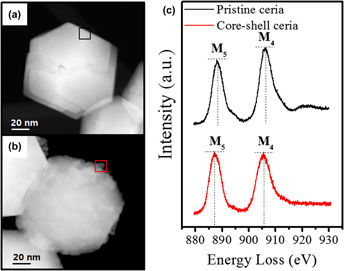Crossref Citations
This article has been cited by the following publications. This list is generated based on data provided by
Crossref.
Kim, Kijung
Yi, Dong Kee
and
Paik, Ungyu
2017.
Increase in Ce3+Concentration of Ceria Nanoparticles for High Removal Rate of SiO2in Chemical Mechanical Planarization.
ECS Journal of Solid State Science and Technology,
Vol. 6,
Issue. 9,
p.
P681.
Zhang, Peng
Dong, Zhiyuan
Ran, Yuanming
Xie, Hualin
Lu, Yun
and
Ding, Shimin
2018.
Preparation and photocatalytic application of AgBr modified Bi2WO6 nanosheets with high adsorption capacity.
Journal of Materials Research,
Vol. 33,
Issue. 23,
p.
3953.
Calado, Lénia M.
Taryba, Maryna G.
Carmezim, Maria J.
and
Montemor, M. Fátima
2018.
Self-healing ceria-modified coating for corrosion protection of AZ31 magnesium alloy.
Corrosion Science,
Vol. 142,
Issue. ,
p.
12.
Han, Kwang-Min
Han, So-Young
Sahir, Samrina
Yerriboina, Nagendra Prasad
Kim, Tae-Gon
Mahadev, Niraj
and
Park, Jin-Goo
2020.
Contamination Mechanism of Ceria Particles on the Oxide Surface after the CMP Process.
ECS Journal of Solid State Science and Technology,
Vol. 9,
Issue. 12,
p.
124004.
Seo, Jihoon
2021.
A review on chemical and mechanical phenomena at the wafer interface during chemical mechanical planarization.
Journal of Materials Research,
Vol. 36,
Issue. 1,
p.
235.
Huang, Xuelin
Yu, Liang
and
Dong, Yinsheng
2021.
Corrosion resistance of a novel ceria doped aluminum phosphate ceramic coating on cast Al-Si alloy by steam-assisted curing.
Corrosion Science,
Vol. 182,
Issue. ,
p.
109256.
Wu, Bingbing
Wang, Peng
Wang, Yingjie
Qu, Xin-Ping
Tan, Baimei
Hamada, Satomi
Wada, Yutaka
and
Hiyama, Hirokuni
2021.
Removal of Nanoceria Abrasive Particles by Using Diluted SC1 and Non-Ionic Surfactant.
ECS Journal of Solid State Science and Technology,
Vol. 10,
Issue. 3,
p.
034010.
Seo, Jihoon
2021.
A review on chemical and mechanical phenomena at the wafer interface during chemical mechanical planarization.
Journal of Materials Research,
Vol. 36,
Issue. 1,
p.
235.
Seo, Jihoon
2021.
Emerging Contaminants.
Seo, Jihoon
Kim, Kijung
Kang, Hyungoo
and
Babu, S.V.
2022.
Perspective—Recent Advances and Thoughts on Ceria Particle Applications in Chemical Mechanical Planarization.
ECS Journal of Solid State Science and Technology,
Vol. 11,
Issue. 8,
p.
084003.
Lee, Kangchun
Kim, Sungmin
Sun, Seho
Lee, Ganggyu
Kwon, Jiseok
Hwang, Junha
Seo, Jihoon
Paik, Ungyu
and
Song, Taeseup
2022.
Hydrogenated ceria nanoparticles for high-efficiency silicate adsorption.
New Journal of Chemistry,
Vol. 46,
Issue. 43,
p.
20572.
Yeste, Maria Pilar
Hernández-Garrido, Juan Carlos
Kumke, Michael Uwe
Alvarado, Sarah
Cauqui, Miguel Angel
Calvino, José Juan
and
Primus, Philipp-Alexander
2022.
Low-Temperature Growth of Reactive Pyrochlore Nanostructures on Zirconia-Supported Ceria: Implications for Improved Catalytic Behavior.
ACS Applied Nano Materials,
Vol. 5,
Issue. 5,
p.
6316.
Ranaweera, Charith K.
Babu, S. V.
Hamada, Satomi
and
Seo, Jihoon
2022.
Measurement of the force required to move ceria particles from SiO2 surfaces using lateral force microscopy.
Journal of Materials Research,
Vol. 37,
Issue. 10,
p.
1789.
Lee, Jaewon
Kim, Eungchul
Bae, Chulwoo
Seok, Hyunho
Cho, Jinil
Aydin, Kubra
and
Kim, Taesung
2023.
Improvement of oxide chemical mechanical polishing performance by increasing Ce3+/Ce4+ ratio in ceria slurry via hydrogen reduction.
Materials Science in Semiconductor Processing,
Vol. 159,
Issue. ,
p.
107349.
Li, Jing
He, Rucheng
Guo, Guihua
Li, Yao
Liao, Yuanyuan
and
Li, Yongxiu
2023.
Synthesis of Hierarchical Layered Quasi-Triangular Ce(OH)CO3 and Its Thermal Conversion to Ceria with High Polishing Performance.
ACS Omega,
Vol. 8,
Issue. 9,
p.
8519.
Myong, Kyong Kyu
Byun, Jinuk
Lee, Jiseok
Lim, Taeho
and
Kim, Jae Jeong
2023.
Development of a pH-independent Post-CMP Cleaning Solution using Phosphoric Acid-based Surfactants for Removal of Ceria Nanoparticles.
ECS Journal of Solid State Science and Technology,
Vol. 12,
Issue. 7,
p.
074004.
Das, Chanchal
Panigrahi, Sampanna
Saha, Vivekananda
Panda, Bholanath
Dhak, Prasanta
Dhak, Debasis
Pulhani, Vandana
Singhal, Pallavi
and
Biswas, Goutam
2024.
Humic acid-nanoceria composite as a sustainable adsorbent for simultaneous removal of uranium(VI), chromium(VI), and fluoride ions from aqueous solutions.
Environmental Science and Pollution Research,
Bae, Kiho
and
Lee, Kangchun
2024.
Restricted hydrolysis reaction of Si3N4 via nonionic polymer adsorption in advanced shallow trench isolation chemical mechanical planarization.
Colloids and Surfaces A: Physicochemical and Engineering Aspects,
Vol. 681,
Issue. ,
p.
132716.
Zhang, H.H.
Bian, H.
Zhang, X.
Zhang, L.
Chen, Y.
Yang, Y.
and
Zhang, Z.
2024.
Preparation and characterization of hollow ceria based smart anti-corrosive coatings on copper.
Surfaces and Interfaces,
Vol. 45,
Issue. ,
p.
103930.
Zhang, H.H.
Zhang, X.
Bian, H.
Zhang, L.
Chen, Y.
Yang, Y.
and
Zhang, Z.
2024.
Benzotriazole loaded CeO2 nano-containers towards superior anti-corrosive silane coating for protection of copper.
Colloids and Surfaces A: Physicochemical and Engineering Aspects,
Vol. 682,
Issue. ,
p.
132844.






